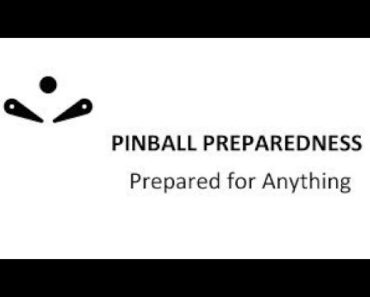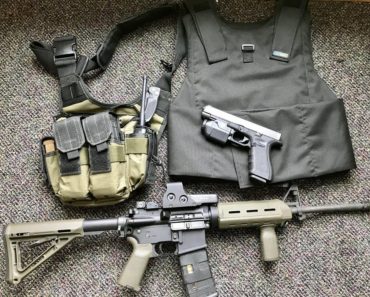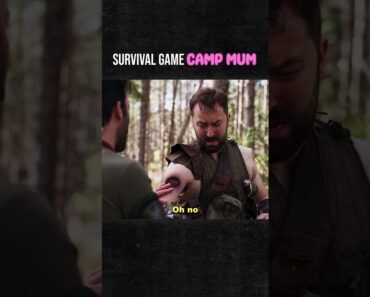Most preventable deaths are attributable to obstructed airways, hemorrhage (excessive blood loss), and shock. Understanding how to identify and treat these three issues maximizes your ability to save lives in medical emergencies.
A helpful mnemonic for remembering the Three Killers is the A, B, Cs of First Aid:
- Airway (Obstructed Airway)
- Blood Loss (Hemorrhage)
- Circulation (Shock)
1. Obstructed Airway
Diagnosis
If the patient is screaming in pain, there is an upside … their airway is not obstructed, and their lungs and diaphragm are working. If you suspect an obstructed airway, look for the following:
- Reaching the throat, difficulty speaking, whistling, wheezing while breathing, unconsciousness, or a bright red or bluish face are potential symptoms of an obstructed airway or choking.
- If you think the patient might be choking and are still conscious, ask them if they are choking. If they nod yes, have someone dial 9-1-1 and move on to treatment.
- If the patient is unconscious and prostrate, try the chin tilt/head lift technique to clear the airway if the patient’s tongue blocks it.
Treatment of a Prostrate Patient with an Obstructed Airway Using the Chin Tilt/Head Lift Technique
- If you suspect that a patient has an obstructed airway, have someone call 911 right away. The clock is ticking, and the patient doesn’t have much time. If you cannot clear the airway quickly, the patient’s life (and future quality of life) may depend on the quick arrival of first responders and the first aid you render until they arrive.
- If the patient is conscious, explain what you intend to do and ask permission to threaten them. If their airway is obstructed, permission will likely be granted in the form of a wide-eyed and panicked nod. If the patient is unconscious or loses consciousness, consent is implied if you act in the patient’s best interest.
- If the patient is already on the ground, put them on their back, try the head tilt/chin lift technique, and check to see if they have resumed breathing. If the patient’s tongue is blocking their airway, tilting the head back and lifting the chin can clear the airway, enabling normal respiration resumption.
- If the patient’s airway is completely blocked and you cannot clear it, they may not make it until help arrives. Check for a pulse. If the heart has stopped, performing chest compressions will circulate the blood, which should still contain some oxygen even if the patient can no longer breathe. The hope is that performing chest compressions will prevent brain damage and keep the patient alive until first responders arrive. Emergency breathing techniques may make it harder to remove the object.
How to Perform the Heimlich Maneuver on a Standing Choking Victim:
- Have someone call 911 or set your phone to speakerphone and call while you are administering first aid.
- Position yourself behind the choking victim.
- Making a fist with one hand, thumb side in, reach around the victim, place it in the abdomen just above the navel and grasp it with the other hand.
- Perform 6-10 sharp upward thrusts to dislodge the stuck object.
- Stop when the foreign object is dislodged.
- If the patient loses consciousness, begin chest compressions.
How to Perform the Heimlich Maneuver on a Prostrate Choking Victim:
- Have someone call 911 or set your phone to speakerphone and call while you are administering first aid.
- Roll the victim onto their back.
- Kneel with your knees, even with the patient’s hips.
- Lean over the patient’s abdomen and place the heel of your hand on the stomach, above the navel, and below the ribcage and place your other hand on top.
- Compress the abdomen with your hands, using your body weight, applying a slightly upward motion. Apply 6-10 compressions. Stop when the foreign object is dislodged.
- If the patient loses consciousness, being chest compressions.
Statistically, 90% of choking deaths occur in children under five years of age. In 65% of choking deaths, the victims are infants, so every parent, grandparent, aunt, and uncle should know what to do.
How to Perform the Heimlich Maneuver on an Infant under one year old:
- If the baby can cry or cough vigorously, it is not choking!
- If the baby is desperately flailing its arms and not making a sound, have someone call 9-1-1.
- Look and listen for breathing sounds.
- Look in the mouth. If you can see the obstruction and can easily remove it, do so only if the baby is unconscious, but don’t probe with your finger. You may wedge the object in tighter.
- If the infant is conscious, place it face down on your forearm with your arm resting on your thigh.
- Administer five quick blows with the heel of the hand between the shoulder blades.
- If the back blows fail to dislodge the foreign object, turn the infant over on its back with the head lower than the chest.
- Place two fingers in the center of the middle of the breastbone, just below the nipples, and press rapidly five times.
- Repeat back blows and finger thrusts until the object is dislodged or the baby loses consciousness.
- If the baby loses consciousness, begin chest compressions.
Hemorrhage
Next on our list is blood loss. As with an obstructed airway, call 911 and stop blood loss if the patient is bleeding.
Diagnosing
- If you see copious amounts of blood, hemorrhage is easy to diagnose. However, bleeding may be internal or may not be immediately apparent due to body position or hidden by clothing or equipment.
- If the patient is conscious, ask and obtain permission before treating the patient. Explain what you intend to do in a calm voice.
- Wear gloves if available. If the wound is spurting blood, also wear a face shield, if available.
- Trauma victims should be checked for bleeding in a head-to-toe assessment. Use your gloved hands to feel underneath the patient and look at your hands to check for blood, moving from head to toe. Because blood is difficult to see on the “tactic-cool” black medical gloves, they are less effective than blue or light tan gloves. So be sure to stock light-colored nitrile gloves in your trauma kit to make it easier to spot blood in triage by touch!
Treatment of Hemorrhage: Stop the bleeding!
- If blood is spurting, severe bleeding, and you suspect internal bleeding, there is a deep penetrating injury or the bleeding can’t be stopped after 10 minutes of direct pressure, have someone dial 9-1-1.
- Apply direct pressure to the wound with a dressing or other absorbent material until the bleeding stops. If dressings are not available, use a clean cloth, towel, clothing, or your hands.
- If the bleeding is severe, likely to be difficult to control, and the wound site is not near the eyes, apply a hemostatic dressing (dressing treated with a blood-clotting agent) if available.
- Once applied, don’t remove the dressing, including checking if the wound has stopped bleeding! If you do, you will rip away blood that has already clotted, destroying any progress the patient has made. If the blood soaks through the first dressing, pile additional gauze (or other absorbent material) on top and keep applying direct pressure.
- Turning the dressing over the wound site as you wrap it will create additional pressure, as will placing one or more gauze rolls over the dressing and continuing to wrap the wound.
- If the injury is to a limb, raise the limb above the heart (if possible) to slow bleeding.
- If the bleeding is severe and cannot be stopped with direct pressure, apply a tourniquet between the wound site and the heart. Write the time on the tourniquet on the patient’s forehead with a sharpie, so health care providers will know how long it has been in place.
Don’t worry about sterile dressings and disinfect the wound until after the bleeding has been stopped. Infection can be treated with antiseptics and antibiotics, provided the patient survives to that point. The priority is getting the bleeding stopped.
Wash your hands after treating severe bleeding to protect yourself against bloodborne pathogens.
Impalement
If a foreign object impales the patient, DO NOT remove the object. It may be preventing blood loss, much like a cork in a bottle. Pull the cork, and the bottle will empty. Leave the object in place. Dress the wound with the object in place. You may need to immobilize both the patient and the object with a backboard or a chair and splinting. You may need to shorten the object to treat or transport the patient. This is OK as long you do not move the object around, push it in deeper, or pull it out at all.
Shock
The symptoms of circulatory shock:
- Initially, heart rate increases.
- Urine output decreases.
- Next, the pulse becomes weak, and blood pressure drops.
- You may notice the lips, tongue, or nails turning blue as cyanosis sets in due to decreased blood circulation.
- With septic shock (a response to severe infection), the symptoms are high fever and sweating.
- With hypovolemic shock (decrease in blood volume due to blood loss or severe dehydration), the patient may become tired, disoriented, restless, or show symptoms of anxiety or fatigue. The skin may become cold and clammy, sweaty, and mottled, or patchy. The pupils may become dilated.
- If the condition progresses, the patient may experience a heart attack or organ failure.
If you suspect shock, perform a capillary refill test. The object is to measure how long it takes for the capillaries to refill after applying pressure to a nail bed.
Diagnosing Shock with the Capillary Refill Test
The capillary refill test is a quick test to see how long it takes for capillaries in a nail bed to refill after pressure is applied.
- As with all procedures, please explain what you are doing and ask the patient for permission before touching them. You know you’re just trying to help the patient, but a patient in shock may not understand that. So, explain what you are doing in a calm voice. Also, wear gloves if they are available.
- Select a nailbed without colored nail polish, or you won’t be able to see the result.
- Press down on the padded area of a fingertip or toe for a few seconds with a finger and then let go, watching skin. Initially, the skin will be blanched (lighter in color), where the pressure from your finger expelled blood from the capillaries. Still, they should quickly refill, matching the color of the surrounding skin. If it takes longer than two seconds for color to return, the patient may be experiencing a circulatory shock.
- The nailbed can also be used, but this site can be unreliable if the patient wears fingernail polish or artificial fingernails. The top of the sternum can also be used.
Cold ambient temperatures, old age, hypothermia, and peripheral vascular disease can also cause delayed capillary refill time. Because the treatment for shock is raising the feet slightly above the heart and covering the patient with a blanket, it may also help a patient suffering from cold exposure.
Treatment of Shock
- If capillary refill time is longer than 2 seconds, have someone dial 9-1-1, lay the patient down, raise the feet and legs about 12″ above the head and cover with a blanket to keep them warm.
- Do not move the patient if you suspect a spinal injury, broken pelvis, or another injury that would preclude movement, do not move the patient or elevate the legs.
- If the patient vomits, turn them on their side to keep their airway clear.
- Treat any life-threatening injuries.
- Loosen any restrictive clothing.
- Reassure the patient and keep them still. Do not move them unless they are in danger.
- Please do not give them anything to eat or drink.
- First responders will transport the patient to a hospital and may begin IV fluids. Once at the hospital, doctors diagnose and treat the injury or ailment that caused the patient to go into shock.
A mnemonic for treatment of shock is: “Face is pale? Raise the tail!”
Knowing how to recognize and treat the Three Killers will maximize your ability to save lives and give you the best return on investment for the time you spend in first aid training.




























